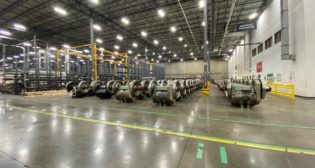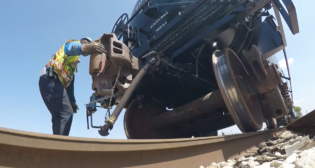
Do We Need Another North American Railcar Builder?
Written by Robert H. Cantwell, Contributing EditorARS Canada Rolling Stock Co. is entering the North American freight railcar market with support from a $3 million repayable contribution from the New Brunswick Provincial government in Canada. Here we go again.
ARS’s manufacturing plant, to be located in Moncton, N.B., promises to create 83 jobs, with prospects to grow to 100 jobs over the next two years.
The North American railcar market is extremely cyclical, making it very difficult for freight railcar builders and component supply companies to manage the peaks and valleys. Because of this cyclicality, numerous carbuilders and suppliers have come and gone over the decades. To illustrate my point, below are excerpts from “Don’t We Ever Learn?,” a Railway Age article written in 2002 by Editor-in-Chief William C. Vantuono:
“Cyclical buying practices have once again caused the bottom to fall out of the freight car market and the return of ‘feast and famine,’ and is causing some industry observers to compare today’s freight car market with the passenger car market a couple decades ago … Is this anyway to run an industry? Haven’t we learned anything during the past 30 years, when production has ranged from 84,579 cars to 5,590 annually? Will it be possible to get off this roller coaster and settle into a more economical pattern of predictable buying cycles brought about by better planning on the part of buyers?”
Remember, this was 2002!!
Since the article was written, the freight railcar supply industry endured another boom and bust during the financial crisis. Approximately 69,000 railcars were delivered in 2005, and by 2010, deliveries had fallen to about 16,600. As recently as 2015, North American freight railcar builders and their suppliers churned out 82,296 railcars, while today the industry is facing the prospect of delivering about 21,000 railcars in 2021.
I guess we really haven’t learned anything.
Fast forward to 2021, and now we’re adding more capacity to this market?
Since the Railway Age article of 2002, significant railcar manufacturing rationalization has taken place, and several carbuilding companies either didn’t survive or shut plants down. Railcar production facilities in towns like Roanoke, Va.; Danville, Ill.; Wilmington, N.C.; Shoals, Ala.; and Lewistown, Pa., all experienced the benefit of employing hundreds, but suffered considerably as the market deteriorated. Those plants are no longer producing railcars, and those towns are no longer employing hundreds, if not thousands.
Government support for upstart railcar builders is nothing new.
Since 2002, Vertex Railcar and National Alabama have come and gone. National Alabama in particular enjoyed considerable government support to the tune of hundreds of millions of dollars. Let’s look closer at these two examples and try to learn from them:
The National Alabama plant is a 2.1 million-square-foot behemoth sitting on 635 acres that cost $300-$350 million to build. Most of the funding was provided by the Retirement System of Alabama. The plant had projected capacity of 8-10,000 railcars annually, with ultimate employment of 1,800. The project was announced in 2007, again with great fanfare: “Successfully recruiting National Alabama was a team effort,” quoted then-Governor Bob Riley. The plant was constructed in a very short 18 months, with production to commence in 2009. Carbuilds were 63,149 in 2007, and by 2010, had fallen to about 16,600. Someone ignored the cycle.
We all know what has happened to National Alabama during the past 12 years: National Steel Car exited, Navistar stepped in, and then FreightCar America (FCA) sublet a portion of it. FCA tried hard to make a go of it, but finally, in December of 2020, the company relocated production to Mexico. It couldn’t make the plant, or the business, work. FCA, long-established in the industry, hasn’t been profitable since 2016.
On Nov 13, 2014, then-Governor of North Carolina Pat McCrory announced the startup of Vertex Railcar, occupying a vacated Terex plant in Wilmington. The company was “going to be at the forefront of the railcar building industry by supplying massive demand for tank cars.” In December, 2015, Vertex delivered its first 30 cars. The local and state governments kicked in about $1 million for roadwork, while the company sought additional government incentives, but to no avail (smart move Wilmington).
What made Vertex unique was its ownership structure: It had the backing of China’s CSR Corp. Ltd. (China Southern) rolling stock company, which owned 22%; Hong Kong-based Majestic Legend Holdings, which owned 45%; and Vertex Rail Technologies, which owned 33%. By the end of 2015, ownership had shifted to 50% Chinese, as CSR merged with China CNR Corp. Ltd. (China Northern) to become the juggernaut CRRC. Since CRRC is an SOE (state-owned enterprise), its loans to Vertex could be considered government support.
With the backing of the Chinese government to the tune of almost $45 million, Vertex possessed a unique competitive advantage. But the company ran into numerous legal problems over railcar designs, while the market shifted away from tank cars toward hopper cars. By November 2015, Vertex declared bankruptcy and subsequently liquidated. It’s just as well. The market has tanked ever since then, no pun intended.
The North American freight railcar market is challenging to navigate, as history has taught us. It takes companies with strong, “fortress” balance sheets to weather the downturns and be able to financially afford the upturns (it takes lots of working capital to ramp up). Because of this cyclicality, new entrants to the market need to have a strong competitive advantage: either a unique design, a low cost structure, or geographic advantage—or perhaps just a lot of cash to burn! Absent these, simply starting up a plant to employ people doesn’t make sound business sense.
Moncton and the Province of New Brunswick, consider these examples before moving too far, too fast. ARS Canada Rolling Stock got its start when it acquired the assets of bankrupt Industrial Rail Services/IRSI in 2015. The Provincial government lost $20 million in loans and loan guarantees when IRSI went belly-up. It could happen again.
Robert H. Cantwell spent the first 26 years of his rail industry career growing a successful company, Hadady Corp., a designer and manufacturer of truck (bogie) components and systems for locomotives and transit railcars. Following the sale of his business, Bob helped transform Amsted Rail, holding various executive positions for 16 years. He has been active in the Rail Transportation Division of the ASME (American Society of Mechanical Engineers) and is past Chairman of the Division. He has also actively advocated with members of Congress in support of the rail and rail supply industry. Bob holds degrees in Mechanical Engineering from the Georgia Institute of Technology and an MBA from the University of Chicago. He possesses a unique perspective on the rail supply industry, combining his engineering experience along with robust economic and financial acumen. As an active investor in the rail industry, he has a vested interest in the success of the industry.



